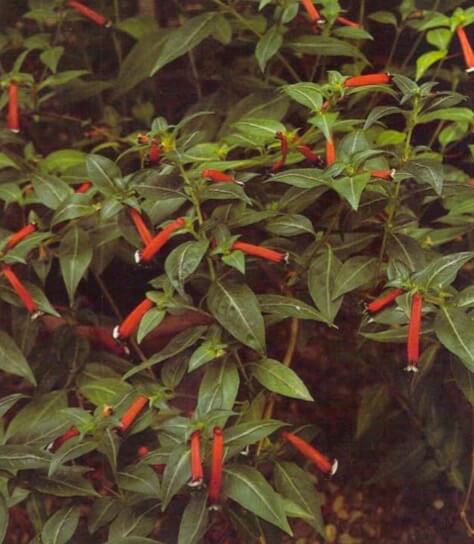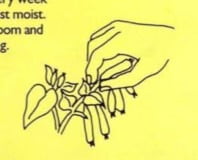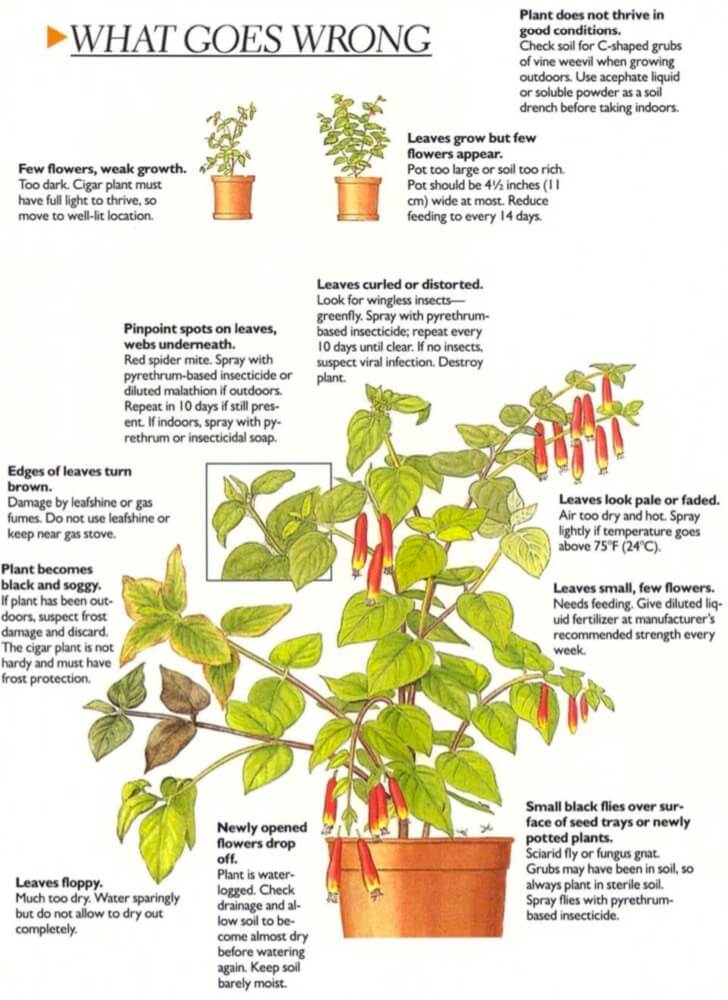[Ebook Việt Hoá] The Instant Guide to Healthy Houseplants (Hướng dẫn tức thời để chăm cây trong nhà khoẻ mạnh), Chi Cuphea
[Ebook Việt Hoá] The Instant Guide to Healthy Houseplants: Cuphea ignea (Cigar plant, Firecracker plant, Mexican cigar plant)
- Nguồn: [Ebook Việt Hoá] The Instant Guide to Healthy Houseplants (Hướng dẫn tức thời để chăm cây trong nhà khoẻ mạnh)
- Biên tập: Dũng Cá Xinh
- Biên dịch: Team Codai.net
English
The cigar plant gets its name from cigar like flowers that are actually long crimson tubes with curious black-and-green tops. It is really a perennial but is best treated as an annual when grown indoors or outdoors in the snow-belt states. It is an easy plant to raise from seed. Sow in early spring in a tray of seedling soil, lightly cover with regular soil and place in a plastic bag. Cover with paper until germinated, then move into light. Prick off seedlings into small containers when large enough to handle and keep them just moist at all times. Choose the strongest ones for potting into individual 4 1/2-in (11 cm) pots.

Light
Needs full light at all times, di- rect sun if possible. Plant will not flower in shade.
Temperature
Minimum for germination, 70°F (21°C). Grows best at 55-65°F (13-18°C); will continue to thrive down to 45°F (7°C) if kept in full light.
Water
Does best in soil that is just moist, so water weekly-twice a week in very hot weather.
Humidity
Spray daily when not in flower if over 75°F (24°C).
Feeding
After potting in final pot, feed with liquid houseplant food once a week for 3 weeks at manufacturer’s recommended strength, then feed monthly.
Soil
Use well-drained, sterile, loam- based soil or a home mix of 3 parts loam, 2 parts peat and I part sand with trace elements.
After flowering
Flowers, although not long lived, are produced freely for months. Remove dead flower heads to encourage plant to produce buds. When buds stop forming in late autumn or early winter, plant is usually discarded. It is possible to take cuttings, but this offers no advantage over spring sowing except for slightly earlier flower- ing. If saving cuttings, keep in a well-lit room at 45°F (7°C) and water only about every week to 10 days to keep just moist. Bring into warmer room and sunlight in early spring.

What Goes Wrong

- Plant does not thrive in good conditions: Check soil for C-shaped grubs of vine weevil when growing outdoors. Use acephate liquid or soluble powder as a soil drench before taking indoors.
- Few flowers, weak growth: Too dark. Cigar plant must have full light to thrive, so move to well-lit location.
- Pinpoint spots on leaves, webs underneath: Red spider mite. Spray with pyrethrum-based insecticide or diluted malathion if outdoors. Repeat in 10 days if still present. If indoors, spray with pyrethrum or insecticidal soap.
- Leaves grow but few flowers appear: Pot too large or soil too rich. Pot should be 4 1/2 inches (11 cm) wide at most. Reduce feeding to every 14 days.
- Edges of leaves turn brown: Damage by leafshine or gas fumes. Do not use leafshine or keep near gas stove.
- Plant becomes black and soggy: If plant has been outdoors, suspect frost damage and discard. The cigar plant is not hardy and must have frost protection.
- Leaves look pale or faded: Air too dry and hot. Spray lightly if temperature goes above 75°F (24°C).
- Leaves small, few flowers: Needs feeding. Give diluted liquid fertilizer at manufacturer’s recommended strength every week.
- Leaves floppy: Much too dry. Water sparingly but do not allow to dry out completely.
- Newly opened flowers drop off: Plant is waterlogged. Check drainage and allow soil to become almost dry before watering again. Keep soil barely moist.
- Small black flies over surface of seed trays or newly potted plants: Sciarid fly or fungus gnat. Grubs may have been in soil, so always plant in sterile soil. Spray flies with pyrethrum-based insecticide.
- Leaves curled or distorted: Look for wingless insects- greenfly. Spray with pyrethrum-based insecticide; repeat every 10 days until clear. If no insects, suspect viral infection. Destroy plant.
Tiếng Việt
Cây xì gà được đặt tên từ những bông hoa giống điếu xì gà thực sự với những ống dài màu đỏ thẫm và ngọn màu xanh đen lạ mắt. Nó là một cây lâu năm nhưng được coi như cây trồng trong nhà hoặc ngoài trời ở các bang vành đai tuyết. Đây là một loại cây dễ trồng từ hạt. Gieo vào đầu mùa xuân trong khay đất, phủ nhẹ đất thường xuyên và cho vào túi ni lông. Che bằng giấy cho đến khi nảy mầm, sau đó di chuyển ra ánh sáng. Cất cây con vào thùng nhỏ khi đủ lớn để xử lý và luôn giữ ẩm cho chúng. Chọn những bầu đất khỏe nhất để làm thành 4 bầu 1/2 inch (11 cm) riêng lẻ.

Ánh sáng
Lúc nào cũng cần đầy đủ ánh sáng, nắng trực tiếp. Cây sẽ không ra hoa trong bóng râm.
Nhiệt độ
Tối thiểu để nảy mầm là 70 ° F (21 ° C). Phát triển tốt nhất ở 55-65 ° F (13-18 ° C); sẽ tiếp tục phát triển mạnh xuống đến 45 ° F (7 ° C) nếu được giữ trong ánh sáng đầy đủ.
Nước
Tốt nhất ở đất vừa ẩm, vì vậy hãy tưới nước hàng tuần-hai lần một tuần khi thời tiết quá nóng.
Độ ẩm
Phun hàng ngày khi không có hoa nếu nhiệt độ trên 75 ° F (24 ° C).
Bón phân
Sau khi trồng trong chậu cuối cùng, bón bằng phân bón hữu cơ dạng lỏng mỗi tuần một lần trong 3 tuần theo khuyến cáo của nhà sản xuất, sau đó bón hàng tháng.
Đất
Sử dụng đất mùn thoát nước tốt, vô trùng, hoặc hỗn hợp gia đình gồm 3 phần mùn, 2 phần than bùn và một phần cát với các nguyên tố vi lượng.
Sau khi ra hoa
Hoa mặc dù không sống lâu nhưng nở trong nhiều tháng. Loại bỏ các đầu hoa chết để khuyến khích cây ra nụ. Khi chồi ngừng hình thành vào cuối mùa thu hoặc đầu mùa đông, cây thường bị loại bỏ. Có thể giâm cành, nhưng điều này không mang lại lợi ích gì so với gieo hạt vào mùa xuân ngoại trừ việc ra hoa sớm hơn một chút. Nếu tiết kiệm cành giâm, hãy giữ trong phòng đủ ánh sáng ở 45 ° F (7 ° C) và chỉ tưới nước khoảng mỗi tuần đến 10 ngày để giữ ẩm. Mang vào phòng ấm hơn và ánh sáng mặt trời vào đầu mùa xuân.

Những vấn đề có thể xảy ra

- Cây không phát triển trong điều kiện tốt: Kiểm tra đất tìm những con ấu trùng của mọt nho khi trồng ngoài trời. Sử dụng chất lỏng acephate hoặc bột hòa tan làm chất tẩy rửa đất trước khi sử dụng trong nhà.
- Ít hoa, sinh trưởng yếu: Quá tối. Cây xì gà phải có đầy đủ ánh sáng để cây phát triển mạnh, nên di chuyển đến vị trí có đủ ánh sáng.
- Điểm đốm trên lá, mạng nhện bên dưới: Bọ nhện đỏ. Phun thuốc trừ sâu pyrethrum hoặc malathion pha loãng nếu ở ngoài trời. Lặp lại sau 10 ngày nếu vẫn còn. Nếu ở trong nhà, hãy xịt bằng pyrethrum hoặc xà phòng diệt côn trùng.
- Lá mọc nhưng ít hoa: Chậu quá rộng hoặc đất quá giàu dinh dưỡng. Chậu rộng tối đa là 4 1/2 inch (11 cm). Giảm bón phân xuống 14 ngày một lần.
- Rìa lá chuyển sang màu nâu: Hư hại do xịt bóng lá hoặc khí ga. Không dùng xịt bóng lá hoặc để cây gần bếp ga.
- Cây bị đen và sũng nước: Nếu cây ở ngoài trời, nghi ngờ hư hại do sương giá và loại bỏ. Cây xì gà không cứng và phải được bảo vệ khỏi sương giá.
- Lá nhợt nhạt hoặc phai màu: Không khí quá khô và nóng. Xịt nhẹ nếu nhiệt độ lên trên 75 ° F (24 ° C).
- Lá nhỏ, ít hoa: Cần chăm sóc. Sử dụng phân bón pha loãng theo liều lượng khuyến cáo của nhà sản xuất mỗi tuần.
- Lá bị mềm: Quá khô. Tưới ít nước nhưng không để khô hoàn toàn.
- Hoa mới hé nở thì rụng: Cây bị úng. Kiểm tra hệ thống thoát nước và để đất gần như khô ráo trước khi tưới lại. Hiếm khi để đất ẩm.
- Ruồi đen nhỏ trên bề mặt khay hạt giống hoặc cây mới trồng trong chậu: Ruồi scarid hoặc ruồi ăn nấm. Có thể đã ở trong đất, vì vậy hãy luôn trồng trong đất vô trùng. Phun thuốc diệt côn trùng pyrethrum để diệt ruồi.
- Lá bị quăn hoặc méo mó: Tìm côn trùng không cánh – ruồi xanh. Phun thuốc trừ sâu pyrethrum; lặp lại 10 ngày một lần cho đến khi khỏi hẳn. Nếu không có côn trùng, nghi ngờ nhiễm virus. Phá hủy cây trồng.
![[Ebook Việt Hoá] The Instant Guide to Healthy Houseplants: Cuphea ignea (Cigar plant, Firecracker plant, Mexican cigar plant) [Ebook Việt Hoá] The Instant Guide to Healthy Houseplants: Cuphea ignea (Cigar plant, Firecracker plant, Mexican cigar plant)](https://vn1.vdrive.vn/codai.net/2020/02/ebook-huong-dan-tuc-thoi-cham-cay-trong-nha-khoe-manh-60-cuphea-ignea.jpg)


